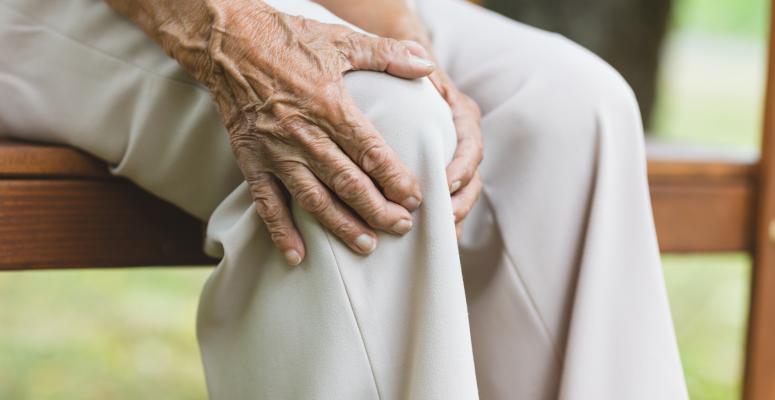
The sciatic nerve starts at the lower back and travels down the hips and buttocks into the legs. Sciatica refers to pain that moves along the sciatic nerve. Sciatica sufferers’ pain levels can range from mild aches to sharp or burning pains. Their pain often flares up while they’re changing positions while sitting or lying down.
Other common symptoms of sciatica are:
- Numbness.
- Muscle weakness.
- Tingling.
Possible reasons you’re feeling knee pain from sciatica
While sciatica can stem from many different causes, there are a few specific possibilities that can cause sciatica-related pain in the knee. The sciatic nerve can affect every area from your lower back all the way down to your feet. As a result, the pain of an injury to or pinching of this nerve can feel like it’s appearing in any area close to the sciatic nerve, including the knee. It’s also possible for part of the sciatic nerve near the knee to become irritated, often by something like tight hamstrings. This irritation may trigger pain that is felt in your knee.
A few other possible reasons for sciatica pain in the knee include:
- Bone disease.
- Infection.
- Spinal stenosis.
- Prolapsed discs.
- Spine trauma.
5 treatment options for knee pain caused by sciatica
Whether your pain is acute (less than six weeks) or chronic (more than six weeks), there are ways to alleviate the sciatic pain in your knee.
- Alternating hot and cold therapy.
- Over-the-counter anti-inflammatory drugs.
- Corticosteroid injections to the spine.
- Physical therapy.
- Spinal surgery.
Surgery isn’t often needed for sciatica pain, but your doctor may recommend it if none of the other treatments are helping.
Dry needling for sciatica pain in the knee
Physical therapy is one of the most effective courses of treatment for a variety of conditions, including sciatica. Even though physical therapy offers patients a variety of pain management exercises, there are two methods that are especially helpful in alleviating sciatica pain.
Let’s start with dry needling. This is a method used by physical therapists that involves piercing the skin with thin needles. This causes your muscles to contract, which can loosen up the tight muscle fibers around the knee. It can accomplish a few things, including:
- Relieving piriformis syndrome —This syndrome is closely related to sciatica because the piriformis muscle is located just above the sciatic nerve. Piriformis syndrome refers to a swelling of the muscle, which can put pressure on the nerve. This pressure can be relieved through dry needling.
- Alleviating muscle tension — There are two pairs of muscles located on either side of the sciatic nerve: the gluteus minimus and gluteus medius. Much like the piriformis muscle, the gluteus minimus can push against the nerve if it’s swollen or strained. Dry needling improves the swelling or straining.
- Transporting nutrients — Dry needling provokes blood flow, which means that the sciatic nerve in the knee can get the oxygen and nutrients it needs to heal.
Dry needling is often confused with acupuncture, but the goals of each method are different. While acupuncture assists with promoting balance, dry needling is used to relieve pain, which is why it’s an effective option for sciatica treatment. It’s also important to note that acupuncture specialists have different training programs than physical therapists who practice dry needling.
Myofascial release for sciatica pain in the knee
While dry needling is a great option for relieving sciatica pain, there is another one that physical therapists often practice. Myofascial release is a hands-on method that relieves tension and pain through manual techniques. It offers a few benefits for people dealing with sciatica of the knee, such as:
- Increased circulation — Myofascial release opens up the blood vessels, which improves circulation. Improved blood circulation can alleviate some of the inflammation and swelling.
- Reduced pain — The myofascial release techniques help to alleviate the tension of the tissue by allowing it to loosen up and lengthen. Relieving the tension will take some of the pressure off the sciatic nerve that’s causing the pain.
- Improved range of motion — Sciatic pain in the knee can prevent your joints from allowing full extension, making it difficult to move your legs freely. By alleviating the tension in the nerves that might be compressed, you can improve your knee’s range of motion.
Alliance PTP is ready to help you find top-notch PT for sciatica of the knee
At Alliance Physical Therapy Partners, we’re proudly bringing together physical therapy practices across the country to help people get the high-quality PT they need.
Want to see a physical therapist in person? We can put you in touch with an Alliance PTP partner that’s close to you and that can help you address sciatica-related knee pain.
Not keen on in-person PT sessions or not close to an Alliance PTP partner? No worries. We also offer effective and affordable virtual physical therapy through our Agile Virtual Physical Therapy platform.
Come find help for your injury or chronic condition today!
Get Help at a Location Near You
